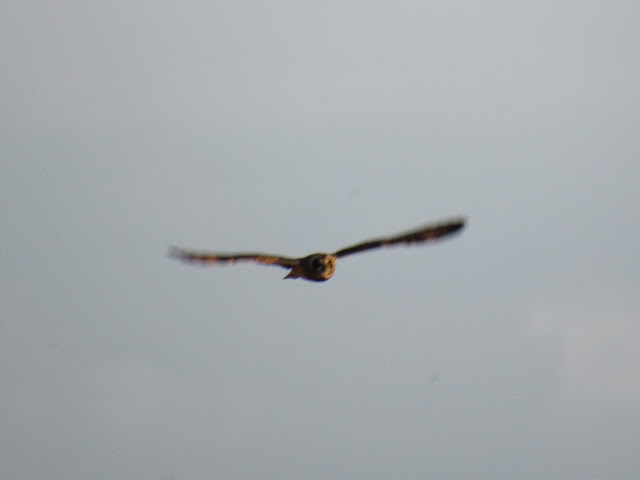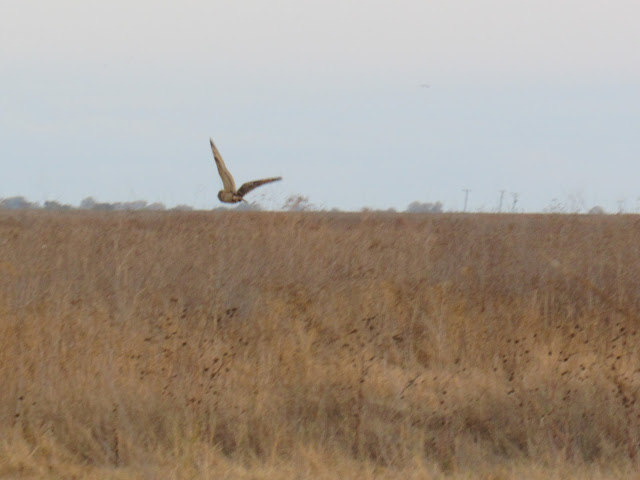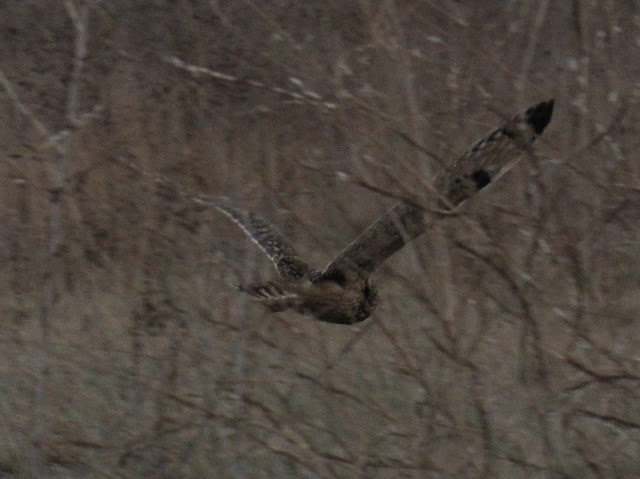Ghosts of the Grassland: Short-eared Owls on the Hunt!
A few days ago, I mentioned that I recently encountered a species that took my breath away and left me shaking with excitement! If you know me, or are anything like me, you know that this kind of reaction is typically caused by an encounter with a member of my favorite group of birds: the owls!
Driving around Merced National Wildlife Refuge's auto tour loop in the early dusk of an overcast day, I casually remarked to Eric that it's funny how everyone pays attention to the wetland ponds on the left side of the road, all but ignoring the grasslands on the right. With heads turned the opposite direction, there could be all kinds of neat birds in the grasslands that would never be seen! To prove my point, car after car rolled slowly by with massive telephoto lenses pointing out the windows, trained on the wetlands and waterfowl, completely obliviously to the grasslands.
It was just a few minutes after I made this observation that I glimpsed a flicker of movement over the grasslands, and in an instant recognized the buoyant flight pattern of a bird I have been hoping to see for the last several winters: a Short-eared Owl!
Now for a disclaimer: I usually aim for a certain level of quality in the photos I share on this blog. Today is the exception! Prepare yourself for a series of frustratingly poor-quality photos of one of the most beautiful and mesmerizing birds I've ever had the privilege to watch. I am a birder with a mediocre camera, definitely not a photographer, and unfortunately, the camera I use does poorly in low-light situations and at capturing birds in flight. All things considered, I'm pretty happy I got photos even this good of owls flying at dusk. (If you'd like to hear more of my excuses, check out last year's Compilation of Terrible Owl Photos!)
The sun was just setting into a bank of thick clouds, but the last rays of golden light lit up the owls (there were in fact two, hunting together) as we watched them through binoculars for about 20 minutes. Back and forth they flew together, crossing paths, dropping low, circling back, at times easily within 10 or 15 yards of our car! Short-eared Owls (Asio flammeus) hunt for small mammals in this manner, coursing low over grasslands, circling around and around a promising patch of ground before dropping suddenly down onto prey concealed in the grass.
I have said over and over to my birding companions that since they favor the same habitat, where you see a Northern Harrier hunting during the day, you are likely to see a Short-eared Owl at dawn or dusk. The presence of Northern Harriers indicates good potential Short-eared Owl habitat. Every time I say it, I kindle the smallest hope that we just might see the long-sought after and elusive Short-eared Owl, but never quite believe it. I have easily seen a hundred Northern Harriers before seeing my first Short-eared Owl!
But imagine how gratifying it was to finally be proven right! You can read all the books and papers and articles you want, but until you experience something for yourself, it never quite seems concrete. As you can see in the pictures above and below, the bird with the narrower wings, small head and conspicuous white rump patch is a familiar Northern Harrier. And the larger bird flying with it, hunting over the same ground, sharing the same habitat? A Short-eared Owl!
When Northern Harriers begin wrapping up their daytime shift, Short-eared Owls take over for the evening. In addition to pygmy owls, Short-eared Owls are among the owls most likely to be seen hunting during the day (though they do prefer dawn and dusk). These photos were captured a little after 4:00 pm on an overcast day at the end of November, when the harriers and the owls were hunting simultaneously.
The silhouette of an owl is unique and entirely different from that of other raptors (hawks, falcons and the like). Perched owls have very rounded, teardrop-shaped bodies, with large round heads that melt into their round bodies. Raptors have distinctively small heads on generally slimmer bodies. In flight, the massively long, rounded wings and chunky heads of owls are a dead give-away.
Short-eared Owls in particular have a distinct flight pattern that makes them immediately identifiable. Their buoyant style of flying has often been likened to that of a butterfly, which is difficult to picture until you see one for yourself. (I looked them up on YouTube once a couple of years ago... so I would be prepared the first time I saw one in the field! Check out this video, since I didn't have the presence of mind to think of filming the two I saw!)
Birds of open country and grasslands, Short-eared Owls are one of the world's most widely distributed owls. In the Americas alone, they breed across much of Canada, Alaska and the northern United States, as well as parts of South America and the Caribbean. During the winter months, they can be found across the middle and southern parts of the U.S. (including California's Central Valley) and Mexico. Worldwide, they breed across much of Europe and Russia, wintering to the south in the Mediterranean, parts of Africa, even India and southeast Asia. Strong flyers and highly migratory, Short-eared Owls are capable of crossing hundreds of miles of ocean. As a result, Hawaii's only native owl, the Peuo (Asio flammeus sandwichensis), is one of ten subspecies of the Short-eared Owl.
Like many other grassland species, habitat loss poses a threat to the future of Short-eared Owl populations. And, as with other raptors, rodenticides are deadly. Consuming a poisoned rat or other rodent "pest" (easy prey) spells certain death for owls. Please, please, please refrain from using poison to exterminate pests, even in places owls are not known to visit. (The chances are very high that there are owls around, unbeknownst to most humans! Most of us live within hooting distance of Great Horned Owls and may never even know it!)
I have a goal of seeing all of North American's 19 species of owl in my lifetime, and these Short-eared Owls are number 10!
Here's an update on my progress:
Owls Seen: Owls Yet To See:
(okay, in two cases, heard only) (Roughly in order of expected difficulty)
Great Horned Owl Northern Saw-whet Owl
Burrowing Owl Spotted Owl
Barn Owl Flammulated Owl
Western Screech-owl Eastern Screech-owl
Long-eared Owl Great Gray Owl
Barred Owl Snowy Owl
Northern Pygmy Owl Northern Hawk Owl
Elf Owl Boreal Owl
Whiskered Screech-owl Ferruginous Pygmy Owl
Short-eared Owl
So you see, I still have quite a way to go! (Aside: if that goal seems too easy, there are nearly 250 species of owl worldwide!!)
Driving around Merced National Wildlife Refuge's auto tour loop in the early dusk of an overcast day, I casually remarked to Eric that it's funny how everyone pays attention to the wetland ponds on the left side of the road, all but ignoring the grasslands on the right. With heads turned the opposite direction, there could be all kinds of neat birds in the grasslands that would never be seen! To prove my point, car after car rolled slowly by with massive telephoto lenses pointing out the windows, trained on the wetlands and waterfowl, completely obliviously to the grasslands.
It was just a few minutes after I made this observation that I glimpsed a flicker of movement over the grasslands, and in an instant recognized the buoyant flight pattern of a bird I have been hoping to see for the last several winters: a Short-eared Owl!
Now for a disclaimer: I usually aim for a certain level of quality in the photos I share on this blog. Today is the exception! Prepare yourself for a series of frustratingly poor-quality photos of one of the most beautiful and mesmerizing birds I've ever had the privilege to watch. I am a birder with a mediocre camera, definitely not a photographer, and unfortunately, the camera I use does poorly in low-light situations and at capturing birds in flight. All things considered, I'm pretty happy I got photos even this good of owls flying at dusk. (If you'd like to hear more of my excuses, check out last year's Compilation of Terrible Owl Photos!)
The sun was just setting into a bank of thick clouds, but the last rays of golden light lit up the owls (there were in fact two, hunting together) as we watched them through binoculars for about 20 minutes. Back and forth they flew together, crossing paths, dropping low, circling back, at times easily within 10 or 15 yards of our car! Short-eared Owls (Asio flammeus) hunt for small mammals in this manner, coursing low over grasslands, circling around and around a promising patch of ground before dropping suddenly down onto prey concealed in the grass.
I have said over and over to my birding companions that since they favor the same habitat, where you see a Northern Harrier hunting during the day, you are likely to see a Short-eared Owl at dawn or dusk. The presence of Northern Harriers indicates good potential Short-eared Owl habitat. Every time I say it, I kindle the smallest hope that we just might see the long-sought after and elusive Short-eared Owl, but never quite believe it. I have easily seen a hundred Northern Harriers before seeing my first Short-eared Owl!
 |
| Left: Northern Harrier. Right: Short-eared Owl |
But imagine how gratifying it was to finally be proven right! You can read all the books and papers and articles you want, but until you experience something for yourself, it never quite seems concrete. As you can see in the pictures above and below, the bird with the narrower wings, small head and conspicuous white rump patch is a familiar Northern Harrier. And the larger bird flying with it, hunting over the same ground, sharing the same habitat? A Short-eared Owl!
 |
| Left: Northern Harrier. Right: Short-eared Owl. |
When Northern Harriers begin wrapping up their daytime shift, Short-eared Owls take over for the evening. In addition to pygmy owls, Short-eared Owls are among the owls most likely to be seen hunting during the day (though they do prefer dawn and dusk). These photos were captured a little after 4:00 pm on an overcast day at the end of November, when the harriers and the owls were hunting simultaneously.
 |
| Left: Northern Harrier. Right: Short-eared Owl. |
The silhouette of an owl is unique and entirely different from that of other raptors (hawks, falcons and the like). Perched owls have very rounded, teardrop-shaped bodies, with large round heads that melt into their round bodies. Raptors have distinctively small heads on generally slimmer bodies. In flight, the massively long, rounded wings and chunky heads of owls are a dead give-away.
Short-eared Owls in particular have a distinct flight pattern that makes them immediately identifiable. Their buoyant style of flying has often been likened to that of a butterfly, which is difficult to picture until you see one for yourself. (I looked them up on YouTube once a couple of years ago... so I would be prepared the first time I saw one in the field! Check out this video, since I didn't have the presence of mind to think of filming the two I saw!)
Birds of open country and grasslands, Short-eared Owls are one of the world's most widely distributed owls. In the Americas alone, they breed across much of Canada, Alaska and the northern United States, as well as parts of South America and the Caribbean. During the winter months, they can be found across the middle and southern parts of the U.S. (including California's Central Valley) and Mexico. Worldwide, they breed across much of Europe and Russia, wintering to the south in the Mediterranean, parts of Africa, even India and southeast Asia. Strong flyers and highly migratory, Short-eared Owls are capable of crossing hundreds of miles of ocean. As a result, Hawaii's only native owl, the Peuo (Asio flammeus sandwichensis), is one of ten subspecies of the Short-eared Owl.
Like many other grassland species, habitat loss poses a threat to the future of Short-eared Owl populations. And, as with other raptors, rodenticides are deadly. Consuming a poisoned rat or other rodent "pest" (easy prey) spells certain death for owls. Please, please, please refrain from using poison to exterminate pests, even in places owls are not known to visit. (The chances are very high that there are owls around, unbeknownst to most humans! Most of us live within hooting distance of Great Horned Owls and may never even know it!)
I have a goal of seeing all of North American's 19 species of owl in my lifetime, and these Short-eared Owls are number 10!
Here's an update on my progress:
Owls Seen: Owls Yet To See:
(okay, in two cases, heard only) (Roughly in order of expected difficulty)
Great Horned Owl Northern Saw-whet Owl
Burrowing Owl Spotted Owl
Barn Owl Flammulated Owl
Western Screech-owl Eastern Screech-owl
Long-eared Owl Great Gray Owl
Barred Owl Snowy Owl
Northern Pygmy Owl Northern Hawk Owl
Elf Owl Boreal Owl
Whiskered Screech-owl Ferruginous Pygmy Owl
Short-eared Owl
So you see, I still have quite a way to go! (Aside: if that goal seems too easy, there are nearly 250 species of owl worldwide!!)















Your excitement conveyed so palpably during the reading of your post! :) Thank you for sharing! Owl encounters feel so special to us too - it's like getting a glimpse of something you're really not supposed to be seeing, and it's so touching and exciting at the same time!
ReplyDeleteThank you for reading!! :) Yes, every encounter with an owl is so special!
Delete